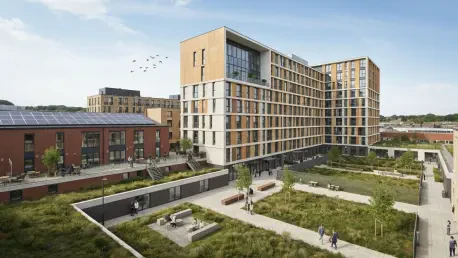Diving into the world of innovative construction and heritage preservation, I’m thrilled to sit down with Luca Calarailli, a seasoned expert in construction, design, and architecture. With a deep passion for integrating technology into building practices, Luca brings a wealth of knowledge to our conversation about St Gabriel’s Court, a landmark £30 million student housing project in central Manchester. This development beautifully marries historic refurbishment with modern construction techniques while prioritizing sustainability and community impact. In our discussion, we explore the intricacies of blending old and new, overcoming logistical challenges, and creating a sustainable living space for students in a vibrant urban setting.
How did the vision for St Gabriel’s Court come together, and what were the key goals for this student housing project in Manchester?
The vision for St Gabriel’s Court was to create a high-quality, sustainable student accommodation that not only met the growing demand for housing in Manchester but also respected and enhanced the heritage of the site. Located at Oxford Place, near major universities, this £30 million project aimed to house 321 students across a mix of cluster bedrooms, studios, and shared amenity spaces. Our goal was to contribute to the regeneration of the local area while preserving the historical significance of buildings like St Gabriel’s Lodge, the 1963 Chapel, and Woodthorpe Hall. It was about striking a balance between modern needs and historical value, ensuring the development complemented the Victoria Park Conservation Area.
What makes the location of this development particularly advantageous for students and the surrounding community?
The location at Oxford Place, just south of Manchester’s city center, is a game-changer. It’s incredibly close to the University of Manchester and Manchester Metropolitan University, making it an ideal spot for students who want easy access to campus. Beyond convenience, the site plays a significant role in the regeneration of the area. By transforming a two-acre plot into a vibrant student community, we’re breathing new life into the neighborhood, fostering a sense of connection and activity that benefits both students and local residents.
Can you describe the design philosophy behind blending refurbished historic buildings with new constructions at St Gabriel’s Court?
Our design philosophy was rooted in respect for the past while embracing the future. For the historic buildings like St Gabriel’s Lodge from the 1850s and Woodthorpe Hall from the 1930s, we focused on sensitive restoration—preserving features like the original stone façade, ornate chimneys, and brickwork. In the 1963 Chapel, we retained unique elements like the zig-zag canopy and replaced windows to match their original design. For the new four- and five-story buildings, we used materials like buff and red brick and aluminum glazing to complement the site’s heritage, ensuring a cohesive look. It was about creating a dialogue between old and new, where each element enhanced the other.
What were some of the toughest logistical hurdles you faced during construction, and how did you overcome them?
The tight, street-facing site posed significant logistical challenges. With limited space for storage and maneuvering, we had to be strategic. We implemented a ‘just-in-time’ delivery system, which meant materials arrived exactly when needed, minimizing congestion and disruption. This approach required precise planning and coordination, but it kept the project on track. Additionally, working on historic structures brought unexpected issues, like sourcing reclaimed bricks for repairs. We tackled these by maintaining flexibility and close collaboration with our team to adapt quickly to any surprises.
How did modern construction techniques play a role in shaping this project, and what benefits did they bring?
Modern Methods of Construction, or MMC, were pivotal in delivering St Gabriel’s Court efficiently. We used precast concrete retaining walls overclad with hand-laid bricks, bathroom pods for some blocks, and prefabricated chimneys made from reclaimed site bricks. These techniques sped up the construction timeline and ensured consistent quality. For instance, in-situ concrete framing and prefabricated stairs allowed us to maintain structural integrity while moving quickly. Importantly, these modern elements were designed to blend seamlessly with the historic aspects, maintaining the site’s character while meeting today’s standards.
Sustainability appears to be a cornerstone of this development. Can you elaborate on the specific features that support this focus?
Absolutely, sustainability was at the heart of St Gabriel’s Court. We integrated photovoltaic panels on the roofs of key blocks and the cycle store to harness solar energy. Ecological enhancements like bat, swift, and sparrow boxes were built into the façades, and bee posts were added to the landscaping. We’re targeting a BREEAM ‘Excellent’ rating for the new blocks and ‘Very Good’ for the refurbished ones, which reflects our commitment to high environmental standards. Upgraded insulation in older structures and a modern energy center further boost efficiency. Preserving mature trees along the frontage also helped maintain the site’s natural character.
In what ways did this project engage with and benefit the local community during and after construction?
Engaging with the local community was a priority. We worked with local supply chain partners wherever possible, which supported the regional economy and fostered strong relationships. Throughout the build, we kept the community informed with regular newsletters and site updates to minimize disruption and build trust. Once completed, St Gabriel’s Court brings a new energy to the area, with hundreds of students contributing to the local vibrancy. It’s not just a place to live; it’s a hub that connects with and uplifts the surrounding neighborhood.
Looking ahead, what is your forecast for the future of student housing projects in urban areas like Manchester?
I believe the future of student housing in urban areas like Manchester will continue to focus on sustainability and integration with local heritage. As cities grow denser, we’ll see more projects like St Gabriel’s Court that repurpose existing structures while incorporating cutting-edge design and technology. The demand for high-quality, eco-friendly accommodations near universities will drive innovation in construction methods and materials. I also expect a stronger emphasis on community impact, ensuring these developments aren’t just isolated buildings but active contributors to the urban fabric. It’s an exciting time for this sector, with endless potential to redefine how we build for the next generation.









